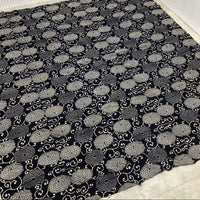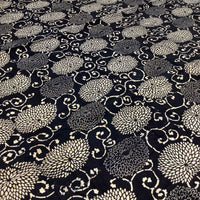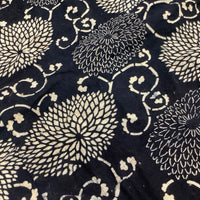






Antique Indigo Katazome Futonji – Chrysanthemum Arabesque, 5 Panels Wide
A beautifully preserved example of antique Japanese futon-ji, this cloth features a repeating chrysanthemum arabesque—one of the most beloved motifs in Japanese textile design. Chrysanthemums (kiku) symbolize longevity, seasonal beauty, and refined elegance, while the scrolling vinework (karakusa) signifies vitality and unbroken connection. Together, they form a pattern that feels both rhythmic and serene, perfectly suited to household textiles that were meant to endure for decades.
This futon-ji was made by joining several narrow widths of handwoven cotton cloth, each originally woven on a small home loom. In Japanese, futon-ji refers to the outer cloth of a traditional futon—futon meaning bedding, and ji meaning the cloth or ground. Before industrial weaving, rural families wove cotton in strips about 13.5–14" wide, then stitched these panels together to form a larger cover. Here, five such panels have been sewn edge-to-edge, and their seams remain visible, evidence of the domestic work and handcraft behind this textile.
The pattern was created using katazome, a traditional resist-dye method in which artisans brush rice-flour paste through hand-cut mulberry stencils. After multiple dips in natural indigo, the paste is washed away to reveal crisp white motifs against a deep blue ground. The subtle irregularities in the lines, the slightly softened indigo, and the gentle variations in tone all speak to the textile’s age and use. This piece shows very little visible mending—a sign that it may have been part of a trousseau or used sparingly in the household. Whether hung as wall art, used as a table covering, or incorporated into boro-inspired work, it is a beautiful example of early 20th-century Japanese craft.
Age & Attribution
This futon-ji is best understood as antique, likely dating from the late Meiji (1868–1912) to early Shōwa period (1926–1940s). Several clues guide this estimate:
-
the narrow handwoven panel construction typical before industrial looms,
-
the katazome stencil style associated with early 20th-century rural workshops,
-
the depth and oxidation pattern of natural indigo dyeing, and
-
the restrained, elegant chrysanthemum arabesque motif common before Westernized design trends took hold.
While precise dating requires provenance, these features strongly suggest an origin in the early decades of the 20th century. We share this reasoning to help you understand how Japanese textile scholars evaluate age through construction, dye, and design.
Dimensions:
59" × 66" (150 × 168 cm)
5 panels wide, based on the standard traditional loom width of approximately 13.5–14" per panel before seam allowances. At five panels wide, this is a larger than the average futon-ji, which is typically 4 panels wide.
Made in Japan







